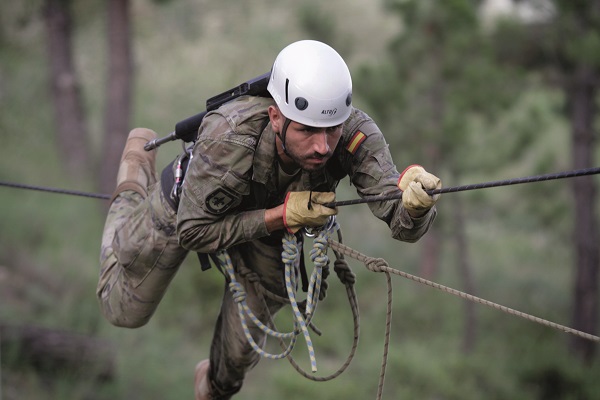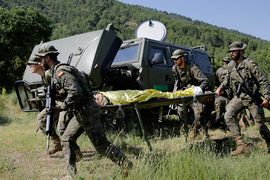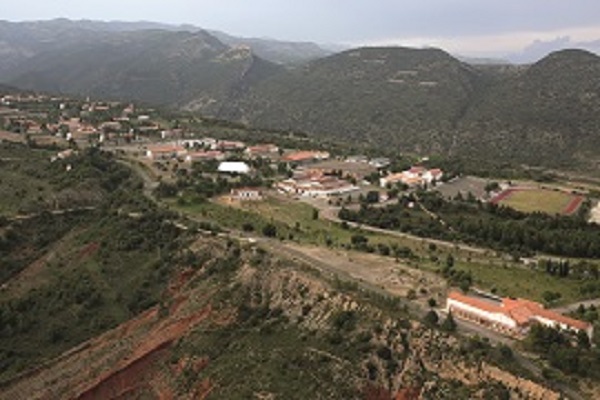'MINERVA', cadets to sergeants
Wednesday, August 29, 2018
Number: 67


Evacuation practice of injured people during the exercise
The sergeant cadets from the XLIII promotion faced their last challenge before the presentation of certificates on 9th July. The “Minerva” exercise is the last one that the aspiring non-commissioned officers must overcome, after preparing in their respective branches. With that, their training plan culminates which will accredit them to perform the rank as sergeants.
The General Basic Non-Commissioned Officers Academy (AGBS) In Talarn (Lerida), where they started their training three years ago, converted in the meeting point for the five hundred aspiring non-commissioned officers. The big challenge was to put everything in common that they had learnt in their respective academies and to face the 22 task stations together which they had to pass through from 25th to 29th June.
The “Minerva” Exercise has already 5 editions, and the academy, as a reference centre for the training of the non-commissioned officers undertakes the challenge to develop its training. For this, the other teaching centres which are involved in the exercise offer their support as well as other additional assistance being provided by units belonging to the Land Force.
The director of AGBS, Colonel Salgado, highlights that the exercise relies on the experience from previous years and therefore it has been improving each year allowing the stations to function according to the needs. “As well as the specific stations, there are other generics which involve everything” explains the colonel.
Objective: leadership
The main purpose of “Minerva” is to encourage leadership in the command exercise as well as the training the units to solve tactical situations.
“They are the cadets themselves of each branch which teach their comrades the characteristics or the aim of each specific task station,” says the director of the academy.
For this, the patrols are made up of personnel from all the fundamental branches. A chief of the patrol is appointed as the head and in turn the unit is formed in two sections. Each one has two sergeant cadets as senior management and between 13 to 14 patrol men.
All the commands are carried out by the sergeant cadets, “We look to put them in a very complicated situation, so that they must present leadership skills over the rest of their comrades” says the Sergeant Major Viñuales, stationed in the AGBS.
The exercise also tries, after two and a half years of training in the academies of fundamental branches, to make sure that the students have cohesion in their promotion. “They joined the academy in 2015 and for a long time were separated so the intention of this exercise is to create a feeling of being one group which is so important” states the Sergeant Major.
"The main objective is to encourage leadership,
in this way all the sergeants cadets lead the different patrols
and sections in function with their branch".
Colonel Salgado, director of the AGBS.

The protocol to follow faced with a threat NBC case is vital to avoid a mass contamination
The execution of the “Minerva”
Before the realisation of the “Minerva” exercise, a preparation phase was carried out on 23rd and 24th June. During these days the necessary means and participating personnel were incorporated and the preparation and delivery of all the material were carried out. After this, from 25th to 29th June, the sergeant cadets began the development of the activity and passed through the task stations in their corresponding patrols.
One of the major difficulties which they had to face was the thermal stress caused by the high temperatures and the difficulties of the practices. The Sergeant Alonso, from Communications emphasises the harshness of the NBC defence practice conditions, the basic-operative level, as they had to put on the NBC suits. However, it must be noted that the exercise has been very productive for them, since it simulates what could occur in reality. “I have completed individual NBC exercises before however this is the first time that I have carried out a supposed situation inspired by a real case, in which the incidents although simulated have caused more tension and realism” he explains.
In all the stations the sergeant cadets had to face situations which closely reflected reality. An example of this has been the combat practice in a population where the The Training Centre “San Gregorio” was responsible. In this task station, the simulated case required tactical movement in a group and the carrying out of a reconnaissance mission in the area. For this an enemy recognition section and an assault section were employed.
"It has been the first time during the exercise that
I have had the opportunity to be interviewed by a journalist.
I think it has been positive experience to learn
about communication techniques".
Sargento Vilanova, Artillería de Campaña
The combat exercise within a population relied on a combat simulator for the HK G-36 rifle. In this way, the sergeant cadets could know if they had been reached by the enemies´fire. The Full Corporal Samelea, based at the Training Centre “San Gregorio” controlled the exercise through the use of a referee pistol. “The objective is to try and capture the leader of a terrorist cell alive, for this they have 90 minutes to equip themselves and execute the exercise” he explains.
In the exercise the Opposition Forces come into play, to represent the enemy forces. “Although the objective of the exercise is maintained, as the cadets progress through changes are introduced to the activity”, claims the Full Corporal.
Although some of the sergeant cadets have previously had the occasion to carry out similar exercises in their respective academies, they recognise that to do this exercise together they will acquire additional knowledge. The Sergeant Berdini, from the Army´s Aviation branch says that he joined in 2011 as a soldier and although some of the practice exercises were not new to him, he underlines that the possibilities and capabilities which an interarmes training can offer.
In the same way the sergeant cadet Morante, from Communications, doesn’t hide the emotion that “Minerva” causes, he himself being a step away from becoming a sergeant, “The Spanish Army, also gives great value to the non-commissioned officers. I feel proud of everything that the Army represents”, he concluded during the exercise..
"They are many units involved so that the cadets
can acquire global knowledge of the different fundamental branches".
Sergeant Major Viñuales
The areas of the exercise
Different tasks of the exercise were distributed in stations throughout four zones in the Comarca de Pallars Jussà and Lerida. Two of them were found in the Academy itself (Zone A and D) whilst the rest were located in the surrounding areas of Aramunt (Zone B) and Salàs (Zone C). The cadets had to pass through the stations during the exercise, led by each different branch. In this way, the four zones were led by the Infantry Academy (Zone A), the Logistics Academy (Zone B), the Artillery Academy (Zone C) and the Engineering Academy (Zone D). The Captain Martin, Head of the Tactical Operations Centre, explains that although the zones were lead by one academy in concrete, in the stations that there were within each zone, there were other units involved or other teaching centres, which made the cadets train together in different types of exercises.

Air view of the General Basic Academy of Non-Commissioned Officers
Photo gallery of the Exercise
THE PARTICIPANTS
Coordinators of the stations
General Basic Academy of Non-Commissioned Officers
Infantry Academy
Calvary Academy
Artillery Academy
Engineering Academy
Logistics Academy
Army Aviation Academy
Training Centre "San Gregorio"
Mountain Military school and Special Operations
Teaching, Instruction, Training and Evaluation Direction
NBC Defence Military School
Other participating Units
20th Field Artillery Regiment
1st Logistic Group
62nd Infantry Regiment “Arapiles”
64th Mountain Troops Infantry Regiment “Galicia”
Regimiento de 1st NBC Regiment;"Valencia" nº
21nd Signals Regiment
3rd Manoeuvre Helicopter Battalion
3rd Medical Group
41st Logistic Support Group
Army Department of Communication
Army Geographic Centre
Army War College
ARMY UNITS
- Araba Álava |
- Albacete |
- Alicante |
- Almería |
- Asturias |
- Ávila |
- Badajoz |
- Barcelona |
- Burgos |
- Cáceres |
- Cádiz |
- Cantabria |
- Castellón |
- Ceuta |
- Ciudad Real |
- Córdoba |
- A Coruña |
- Cuenca |
- Girona |
- Granada |
- Guadalajara |
- Gipuzkoa |
- Huelva |
- Huesca |
- Islas Baleares |
- Jaén |
- León |
- Lleida |
- Lugo |
- Madrid |
- Málaga |
- Melilla |
- Murcia |
- Navarra |
- Ourense |
- Palencia |
- Las Palmas |
- Pontevedra |
- La Rioja |
- Salamanca |
- Segovia |
- Sevilla |
- Soria |
- Tarragona |
- Santa Cruz de Tenerife |
- Teruel |
- Toledo |
- Valencia |
- Valladolid |
- Bizkaia |
- Zamora |
- Zaragoza



